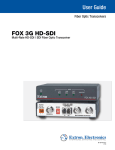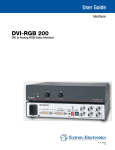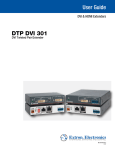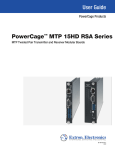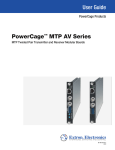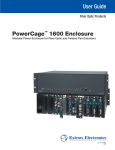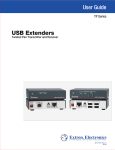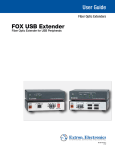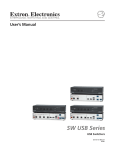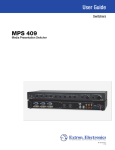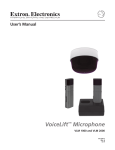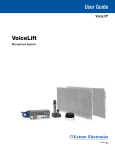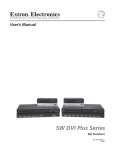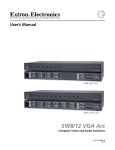Download Extron electronics VoiceLift Installation guide
Transcript
VoiceLift™ Microphone Installation Guide for VLM 1000 and VLM 2000 68-1629-01 Rev. A 01 09 Precautions Safety Instructions • English Warning This symbol is intended to alert the user of important operating and maintenance (servicing) instructions in the literature provided with the equipment. Power sources • This equipment should be operated only from the power source indicated on the product. This equipment is intended to be used with a main power system with a grounded (neutral) conductor. The third (grounding) pin is a safety feature, do not attempt to bypass or disable it. This symbol is intended to alert the user of the presence of uninsulated dangerous voltage within the product’s enclosure that may present a risk of electric shock. Power disconnection • To remove power from the equipment safely, remove all power cords from the rear of the equipment, or the desktop power module (if detachable), or from the power source receptacle (wall plug). Caution Read Instructions • Read and understand all safety and operating instructions before using the equipment. Retain Instructions • The safety instructions should be kept for future reference. Follow Warnings • Follow all warnings and instructions marked on the equipment or in the user information. Avoid Attachments • Do not use tools or attachments that are not recommended by the equipment manufacturer because they may be hazardous. Consignes de Sécurité • Français Power cord protection • Power cords should be routed so that they are not likely to be stepped on or pinched by items placed upon or against them. Servicing • Refer all servicing to qualified service personnel. There are no user-serviceable parts inside. To prevent the risk of shock, do not attempt to service this equipment yourself because opening or removing covers may expose you to dangerous voltage or other hazards. Slots and openings • If the equipment has slots or holes in the enclosure, these are provided to prevent overheating of sensitive components inside. These openings must never be blocked by other objects. Lithium battery • There is a danger of explosion if battery is incorrectly replaced. Replace it only with the same or equivalent type recommended by the manufacturer. Dispose of used batteries according to the manufacturer’s instructions. Avertissement Ce symbole sert à avertir l’utilisateur que la documentation fournie avec le matériel contient des instructions importantes concernant l’exploitation et la maintenance (réparation). Alimentations• Ne faire fonctionner ce matériel qu’avec la source d’alimentation indiquée sur l’appareil. Ce matériel doit être utilisé avec une alimentation principale comportant un fil de terre (neutre). Le troisième contact (de mise à la terre) constitue un dispositif de sécurité : n’essayez pas de la contourner ni de la désactiver. Ce symbole sert à avertir l’utilisateur de la présence dans le boîtier de l’appareil de tensions dangereuses non isolées posant des risques d’électrocution. Déconnexion de l’alimentation• Pour mettre le matériel hors tension sans danger, déconnectez tous les cordons d’alimentation de l’arrière de l’appareil ou du module d’alimentation de bureau (s’il est amovible) ou encore de la prise secteur. Attention Lire les instructions• Prendre connaissance de toutes les consignes de sécurité et d’exploitation avant d’utiliser le matériel. Conserver les instructions• Ranger les consignes de sécurité afin de pouvoir les consulter à l’avenir. Respecter les avertissements • Observer tous les avertissements et consignes marqués sur le matériel ou présentés dans la documentation utilisateur. Eviter les pièces de fixation • Ne pas utiliser de pièces de fixation ni d’outils non recommandés par le fabricant du matériel car cela risquerait de poser certains dangers. Protection du cordon d’alimentation • Acheminer les cordons d’alimentation de manière à ce que personne ne risque de marcher dessus et à ce qu’ils ne soient pas écrasés ou pincés par des objets. Réparation-maintenance • Faire exécuter toutes les interventions de réparation-maintenance par un technicien qualifié. Aucun des éléments internes ne peut être réparé par l’utilisateur. Afin d’éviter tout danger d’électrocution, l’utilisateur ne doit pas essayer de procéder lui-même à ces opérations car l’ouverture ou le retrait des couvercles risquent de l’exposer à de hautes tensions et autres dangers. Fentes et orifices • Si le boîtier de l’appareil comporte des fentes ou des orifices, ceux-ci servent à empêcher les composants internes sensibles de surchauffer. Ces ouvertures ne doivent jamais être bloquées par des objets. Lithium Batterie • Il a danger d’explosion s’ll y a remplacment incorrect de la batterie. Remplacer uniquement avec une batterie du meme type ou d’un ype equivalent recommande par le constructeur. Mettre au reut les batteries usagees conformement aux instructions du fabricant. Sicherheitsanleitungen • Deutsch Vorsicht Dieses Symbol soll dem Benutzer in der im Lieferumfang enthaltenen Dokumentation besonders wichtige Hinweise zur Bedienung und Wartung (Instandhaltung) geben. Stromquellen • Dieses Gerät sollte nur über die auf dem Produkt angegebene Stromquelle betrieben werden. Dieses Gerät wurde für eine Verwendung mit einer Hauptstromleitung mit einem geerdeten (neutralen) Leiter konzipiert. Der dritte Kontakt ist für einen Erdanschluß, und stellt eine Sicherheitsfunktion dar. Diese sollte nicht umgangen oder außer Betrieb gesetzt werden. Dieses Symbol soll den Benutzer darauf aufmerksam machen, daß im Inneren des Gehäuses dieses Produktes gefährliche Spannungen, die nicht isoliert sind und die einen elektrischen Schock verursachen können, herrschen. Stromunterbrechung • Um das Gerät auf sichere Weise vom Netz zu trennen, sollten Sie alle Netzkabel aus der Rückseite des Gerätes, aus der externen Stomversorgung (falls dies möglich ist) oder aus der Wandsteckdose ziehen. Achtung Lesen der Anleitungen • Bevor Sie das Gerät zum ersten Mal verwenden, sollten Sie alle Sicherheits-und Bedienungsanleitungen genau durchlesen und verstehen. Aufbewahren der Anleitungen • Die Hinweise zur elektrischen Sicherheit des Produktes sollten Sie aufbewahren, damit Sie im Bedarfsfall darauf zurückgreifen können. Befolgen der Warnhinweise • Befolgen Sie alle Warnhinweise und Anleitungen auf dem Gerät oder in der Benutzerdokumentation. Keine Zusatzgeräte • Verwenden Sie keine Werkzeuge oder Zusatzgeräte, die nicht ausdrücklich vom Hersteller empfohlen wurden, da diese eine Gefahrenquelle darstellen können. Instrucciones de seguridad • Español Schutz des Netzkabels • Netzkabel sollten stets so verlegt werden, daß sie nicht im Weg liegen und niemand darauf treten kann oder Objekte darauf- oder unmittelbar dagegengestellt werden können. Wartung • Alle Wartungsmaßnahmen sollten nur von qualifiziertem Servicepersonal durchgeführt werden. Die internen Komponenten des Gerätes sind wartungsfrei. Zur Vermeidung eines elektrischen Schocks versuchen Sie in keinem Fall, dieses Gerät selbst öffnen, da beim Entfernen der Abdeckungen die Gefahr eines elektrischen Schlags und/oder andere Gefahren bestehen. Schlitze und Öffnungen • Wenn das Gerät Schlitze oder Löcher im Gehäuse aufweist, dienen diese zur Vermeidung einer Überhitzung der empfindlichen Teile im Inneren. Diese Öffnungen dürfen niemals von anderen Objekten blockiert werden. Litium-Batterie • Explosionsgefahr, falls die Batterie nicht richtig ersetzt wird. Ersetzen Sie verbrauchte Batterien nur durch den gleichen oder einen vergleichbaren Batterietyp, der auch vom Hersteller empfohlen wird. Entsorgen Sie verbrauchte Batterien bitte gemäß den Herstelleranweisungen. Advertencia Este símbolo se utiliza para advertir al usuario sobre instrucciones importantes de operación y mantenimiento (o cambio de partes) que se desean destacar en el contenido de la documentación suministrada con los equipos. Alimentación eléctrica • Este equipo debe conectarse únicamente a la fuente/tipo de alimentación eléctrica indicada en el mismo. La alimentación eléctrica de este equipo debe provenir de un sistema de distribución general con conductor neutro a tierra. La tercera pata (puesta a tierra) es una medida de seguridad, no puentearia ni eliminaria. Este símbolo se utiliza para advertir al usuario sobre la presencia de elementos con voltaje peligroso sin protección aislante, que puedan encontrarse dentro de la caja o alojamiento del producto, y que puedan representar riesgo de electrocución. Desconexión de alimentación eléctrica • Para desconectar con seguridad la acometida de alimentación eléctrica al equipo, desenchufar todos los cables de alimentación en el panel trasero del equipo, o desenchufar el módulo de alimentación (si fuera independiente), o desenchufar el cable del receptáculo de la pared. Precaucion Leer las instrucciones • Leer y analizar todas las instrucciones de operación y seguridad, antes de usar el equipo. Conservar las instrucciones • Conservar las instrucciones de seguridad para futura consulta. Obedecer las advertencias • Todas las advertencias e instrucciones marcadas en el equipo o en la documentación del usuario, deben ser obedecidas. Evitar el uso de accesorios • No usar herramientas o accesorios que no sean especificamente recomendados por el fabricante, ya que podrian implicar riesgos. 安全须知 • 中文 这个符号提示用户该设备用户手册中有重要的操作和维护说明。 这个符号警告用户该设备机壳内有暴露的危险电压,有触电危险。 注意 阅读说明书 • 用户使用该设备前必须阅读并理解所有安全和使用说明。 保存说明书 • 用户应保存安全说明书以备将来使用。 遵守警告 • 用户应遵守产品和用户指南上的所有安全和操作说明。 避免追加 • 不要使用该产品厂商没有推荐的工具或追加设备,以避免危险。 Protección del cables de alimentación • Los cables de alimentación eléctrica se deben instalar en lugares donde no sean pisados ni apretados por objetos que se puedan apoyar sobre ellos. Reparaciones/mantenimiento • Solicitar siempre los servicios técnicos de personal calificado. En el interior no hay partes a las que el usuario deba acceder. Para evitar riesgo de electrocución, no intentar personalmente la reparación/mantenimiento de este equipo, ya que al abrir o extraer las tapas puede quedar expuesto a voltajes peligrosos u otros riesgos. Ranuras y aberturas • Si el equipo posee ranuras o orificios en su caja/alojamiento, es para evitar el sobrecalientamiento de componentes internos sensibles. Estas aberturas nunca se deben obstruir con otros objetos. Batería de litio • Existe riesgo de explosión si esta batería se coloca en la posición incorrecta. Cambiar esta batería únicamente con el mismo tipo (o su equivalente) recomendado por el fabricante. Desachar las baterías usadas siguiendo las instrucciones del fabricante. 警告 电源 • 该设备只能使用产品上标明的电源。 设备必须使用有地线的供电系统供电。 第三条线 (地线)是安全设施,不能不用或跳过 。 拔掉电源 • 为安全地从设备拔掉电源,请拔掉所有设备后或桌面电源的电源线,或任何接到市 电系统的电源线。 电源线保护 • 妥善布线, 避免被踩踏,或重物挤压。 维护 • 所有维修必须由认证的维修人员进行。 设备内部没有用户可以更换的零件。为避免出现 触电危险不要自己试图打开设备盖子维修该设备。 通风孔 • 有些设备机壳上有通风槽或孔,它们是用来防止机内敏感元件过热。 不要用任何东 西挡住通风孔。 锂电池 • 不正确的更换电池会有爆炸的危险。必须使用与厂家推荐的相同或相近型号的电池。 按照生产厂的建议处理废弃电池。 Introduction — Overview FCC Class B Notice This equipment has been tested and found to comply with the limits for a Class B digital device, pursuant to part 15 of the FCC Rules. These limits are designed to provide reasonable protection against harmful interference in a residential installation. This equipment generates, uses and can radiate radio frequency energy and, if not installed and used in accordance with the instructions, may cause harmful interference to radio communications. However, there is no guarantee that the interference will not occur in a particular installation. If this equipment does cause harmful interference to radio or television reception, which can be determined by turning the equipment off and on, the user is encouraged to try to correct the interference by one or more of the following measures: • Reorient or relocate the receiving antenna. • Increase the separation between the equipment and receiver. • Connect the equipment into an outlet on a circuit different from that to which the receiver is connected. • Consult the dealer or an experienced radio/TV technician for help. About This Guide This manual covers the installation of the Extron VoiceLift™ Microphone as part of an Extron PoleVault™ system. The VoiceLift VLR 102 receiver can be installed in a drop ceiling, a standard junction box, an octagonal ceiling box, or on a wall. It is assumed that the installer has some knowledge of and experience with A/V, electrical, or electronic device installation. This manual guides the A/V installer through the steps to install and connect each component of the system. The VoiceLift Microphone The Extron VoiceLift Microphone is an easy-to-use, low-power, classroom amplification system that ensures the teacher can be clearly heard at a comfortable level throughout the classroom. Speech is picked up by the pendant microphone worn by the teacher and is transmitted wirelessly to a base station receiver. The signal is then fed to the PVS 204SA PoleVault Switcher, which powers strategically placed loudspeakers to improve the signal-to-noise ratio of the teacher's voice above ambient noise level. SI 3C LP Plenum Full-Range Ceiling Speakers Free GlobalViewer Software VoiceLift Receiver POWER 12V 3A I N P U T S TCP/IP Network 1A RGB 2A VIDEO 3 MAX RGB 1B 2B 4 VIDEO O U T P U T S ® LISTED US AUDIO/VIDEO 17TT APPARATUS HIGH ON PASS STEREO FILTER ON AMPLIFIED OUTPUTS AUX/MIX OFF DUAL MONO IN RS-232 Tx Rx MLC/IRL IR 12V A B C 4/8 Ohms R DC VOL 10V VOL/MUTE PVS 204SA PoleVault® Switcher / Amplifier VoiceLift 1 O VIDE Y LA 2 SP DI Pendant Microphone X O AU VIDE F OF 3 ON PC ME LU VO G NFI CO E AG IM E MUT 4 4 IP MLC Plus 10 MLC 104 IP Plus MediaLink Controller VoiceLift Microphone installation and wiring overview VoiceLift Microphone Installation • Introduction — Overview 1-1 Introduction — Planning Before You Begin — Planning the Installation Before starting installation, you must consider several major factors to ensure that the installation of the VoiceLift Microphone is as smooth and trouble free as possible, and that the result meets the needs of the users. Placement of the receiver (sensor location) is very important for optimal performance of the VoiceLift Microphone. Because IR technology requires line-of-sight placement, take into consideration anything that could impact or block the transmission of the IR signal from the microphone to the receiver. The lists on the following pages, though not comprehensive, should be consulted to help ensure that key aspects have been considered. 1. Room layout The application diagram below shows a typical classroom installation incorporating the VoiceLift Microphone. VLP 102 Pendant Microphone POWER 12V 3A I N P U T S R W P EGRAHC PVS 204SA 1A RGB 2A VIDEO 3 MAX RGB 1B E rtx no NO 2B /FFO GHC/ETUM 4 VIDEO O U T P U T S ® LISTED US AUDIO/VIDEO 17TT APPARATUS HIGH ON PASS STEREO FILTER ON AMPLIFIE D AUX/MIX OFF DUAL MONO IN RS-232 Tx Rx MLC/IRL IR 12V A B C OUTPUTS 4/8 Ohms R DC VOL 10V VOL/MUTE SI 3C LP IN AUDIO TER IN COMPU IN AUDIO L R Plenum Full-Range Ceiling Speakers IN VIDEO 1 VIDEO Y 2 DISPLA AUX VIDEO OFF 3 ON PC E 4 VOLUM CONFIG IMAGE MUTE 104 IP Plus MLC TCP/IP Network PoleVault Switcher VLR 102 Receiver Extro n VLC 102 Desktop Charging Station Typical classroom installation N Due to the operating frequencies of the microphone and receiver, lighting fixtures such as fluorescent lights and plasma displays should not affect performance of the system. 1-2 VoiceLift Microphone Installation • Introduction — Planning Room considerations Room factors to be considered should include, but are not confined to: • Room configuration Room size, orientation, and layout Location of windows, doors, skylights, etc., for potential light interference Alcoves, bays, or sheltered areas Location of any dark or covered walls (Dark surfaces reduce reflection of the IR signal.) – – – – Wall art Curtains/blinds Acoustical panels Wall material/texture • Line-of-sight obstructions between microphone and receiver Existing movable furniture (desks, tables, podiums) Existing installed furniture (bookcases, racks, cabinets, workbenches, sinks, etc.) Support pillars Projector • Ceiling and wall type (important in assessing the installation hardware needed) Ceiling type (drop, spline, hard lid, etc.); structural type (wood, concrete, trusses) Wall type (drywall, cement, brick, etc.) • Receiver location Best location: on the ceiling, at the middle of the classroom If ceiling mounting is not possible, place high and centered on the longest wall. Locations to avoid: – – – – Places where line of sight could be obstructed; e.g., too close to the projector Corners of the room On walls, at less than 6' or more than 12' up from the base Areas that receive direct sunlight PVT A/V Wallplate Location Potential VLR 102 IR Receiver Locations Screen/White Board Location Teacher’s Desk TV / VCR / DVD Inputs MLC Controller Location Projector/ Switcher Location Speaker Locations Student Desks Example of a classroom installation VoiceLift Microphone Installation • Introduction — Planning 1-3 Introduction — Planning, cont’d • Optional VLR 102SR Secondary receiver. One or more secondary receivers (VLR 102 SR) may be needed if any of the following conditions exist: The room is larger than 40' by 40'. Obstructions exist between the microphone and the receiver. The room is odd-shaped, e.g., L-shaped or long. The room has recessed or sheltered areas, such as alcoves or bays. The room has large windows or windows on multiple walls. Portions of the walls are dark and/or covered. Dark surfaces reduce signal reflection. Take the following into consideration: – – – – Wall art Curtains/blinds Acoustical panels Wall material/texture The following diagrams show examples of secondary receiver placement. Receiver and one secondary receiver in an odd-shaped room Receiver and one secondary receiver in a long room Receiver and three secondary receivers in a large room, or a room with dark walls, obstructions, and/or windows 1-4 VoiceLift Microphone Installation • Introduction — Planning Introduction — Inventory Overview 2. Inventory a. Included items The VoiceLift Microphone is shipped in one box and is available in two package configurations: • VLM 1000 (part #42-139-01): one VLP 102 pendant microphone, a VLR 102 Receiver, and a wall charger. • VLM 2000 (part #42-139-02): two VLP 102 pendant microphones, a VLR 102 Receiver, and a VLC 102 charging station. Carefully check all the received items against the following inventory lists. VoiceLift Microphone Devices and Hardware VLM 2000 VoiceLift Microphone #42-139-02 W R CHARGE tro Ex tro ON OFF/MUTE/CHG n ON ON OFF/MUTE/CHG VLR 102 IR Receiver VLP 102 Pendant Microphone n OFF/MUTE/CHG Ex n CHARGE P P W R W P tro CHARGE Ex R VLM 1000 VoiceLift Microphone #42-139-01 VLP 102 Pendant Microphones (2) VLR 102 IR Receiver Adapter VLC 102 Charging Station Adapter Wall Charger/ Power Supply AA Rechargeable Battery Z Bracket and Screw Lanyard Lanyard (2) Z Bracket and Screw Wall Charger/ Power Supply 15’ Ethernet Cable VLP 102 Pendant Microphone VLR 102 IR Receiver RJ-45 to C/S adapter Wall charger/power supply Ethernet cable, 15 ft. Battery, AA 2500mAh Lanyard Z bracket Z bracket screw AA Rechargeable Batteries (2) VLP 102 Pendant Microphones (2) VLR 102 IR Receiver VLC 102 Charging Station RJ-45 to C/S adapter Wall charger/power supply 15’ Ethernet Cable Ethernet cable, 15 ft. Batteries, AA 2500mAh (2) Lanyard (2) Z bracket Z bracket screw VoiceLift Microphone Installation • Introduction — Inventory Overview 1-5 Introduction — Inventory Overview, cont’d N If any items in the VoiceLift Microphone boxes are damaged or missing, contact the Extron Technical Hotline (see rear cover for contact numbers). b. Items not included The following items are not included. However, some or all of these items may be needed for the installation at your particular site. • Additional length of RJ-45 cabling (CAT 5, 5e, or 6 with T568A or T568B straight-through wiring) • Installation hardware (may vary by installation): Electrical ceiling box, 3.5" or 4.0" Junction box Plaster ring Raceway Bolts for concrete structural ceilings where needed Dry wall anchors and screws Spare ceiling tiles in case of accidental damage during installation Safety wire, lag eye bolts, and strain reliefs Heat shrink, extension cord c. Optional items The optional items suggested below can be added to or substituted for items in the standard VoiceLift Microphone kit. • VLR 102 SR Secondary VoiceLift Receiver • VLC 102 Charging Station • VLP 102 pendant microphone (additional) • Wall charger • Headset microphone • Lapel microphone • Lanyard • Lanyard clip • IPL T S1 Ethernet Control Interface d. Installation tools: • Tape measure • Screwdriver set and Tweeker • Hole saw, keyhole saw, or razor knife • Appropriate drill and bit set for the mounting surface • Stud finder • Flashlight • Safety goggles • RJ-45 crimpers and connectors (plenum rated, if applicable) • Zip ties • Vacuum cleaner 1-6 VoiceLift Microphone Installation • Introduction — Inventory Overview Installation — Overview N For operation and setup of other Extron PoleVault system components mentioned in this guide, refer to the appropriate user manual provided with each product. This overview outlines the basic steps for installing the VLR 102 VoiceLift Receiver. Detailed descriptions with illustrations of these steps are provided in three sections, stages One through Three. If VLR 102 SR Secondary Receiver(s) are being used with your system, this installation procedure applies to them as well. N • • • • Additional installation hardware is needed for this installation, and should be supplied by the installer. See “Items not included,” in chapter 1, “Introduction,” for a list of items that you may need. Optional accessories may be desired for this installation. See “Optional items”, in chapter 1, “Introduction,” for a list of available accessories, or visit www.extron.com for details. Refer to local building standards and codes to verify that the installation will meet all the regulatory requirements. Observe all local and national building and safety codes, UL requirements, and ADA Accessibility Guidelines. Mounting the VoiceLift receiver to a wall Mounting the VoiceLift receiver in a drop ceiling. Mounting the VoiceLift receiver in a junction box The following pages contain instructions for installing the VLR 102 IR Receiver. Where possible, line drawings and photos from an actual installation are used to clarify some of the steps discussed in the text. Each image has a number corresponding to the step that is being described (e.g., ). Ñ VoiceLift Microphone Installation • Installation — Overview 2-1 Installation — Overview, cont’d Outline of installation steps Stage 1 — Install the VLR 102 Receiver Drop ceiling: c Cut a hole in the ceiling tile. (page 2-4) c Mount the receiver housing to the ceiling tile. (page 2-4) c Attach a conduit to the back plate if needed. (page 2-5) Junction box: c Install the junction box. (page 2-6) c Attach the receiver housing to the junction box. (page 2-6) c Attach a conduit to the junction box if needed. (page 2-6) Wall or other hard surface: c Install a raceway if needed. (page 2-7) c Mark the mounting screw locations on the surface. (page 2-7) c If using a raceway, remove the appropriate knockout in the receiver housing. (page 2-7) c Mount the receiver housing to the surface. (page 2-8) Stage 2 — Connect the VLR 102 Receiver to the PoleVault System c Pull the cables to the receiver. (page 2-10) c Connect the cables to the receiver. (page 2-10) c Attach the receiver dome to the housing. (page 2-11) c Pull cables to the PoleVault switcher. (page 2-13) Stage 3 — Configure and Test the System c Configure the system. (page 2-14) c Set up the microphone. (page 2-14) c Test the system. (page 2-14) c Complete the installation. (page 2-15) 2-2 VoiceLift Microphone Installation • Installation — Overview Installation — Stage 1 Stage 1 For instructions on the type of installation you are planning, proceed to one of the pages listed below: • Drop ceiling — page 2-4 • Junction box — page 2-6 • Wall or other hard surface — page 2-7 This stage consists of installing the pieces of hardware shown below. Receiver housing and back plate Conduit Knockouts (2) Back Plate Z bracket and mounting screw (for installation in a drop ceiling) Raceway Knockouts (2) Receiver Housing Where it goes: The housing attaches to the receiver dome, and the back plate mounts to a ceiling tile or a wall. What it does: Protects the receiver base plate and connectors. The housing contains knockouts for different sizes of raceways, and the back plate contains knockouts for conduits. Where it goes: The mounting screw passes through the receiver’s back plate, through the hole in the ceiling tile, then through the ring in the bracket. The bracket is attached to the screw on the back side of the ceiling tile. What it does: Fastens the receiver to a tile in a drop ceiling. VoiceLift Microphone Installation • Installation — Stage 1 2-3 Installation — Stage 1, cont’d Installing the Receiver in a Drop Ceiling 1. Cut a hole in the ceiling tile. a. Remove the ceiling tile in which the receiver will be installed. b. Determine the hole location, then cut a hole in the ceiling tile 2" to 3.5" in diameter, using a circular saw (shown at right) or other type of saw. (Saws are not included.) N This hole should be large enough to expose the conduit knockout and the hole for the mounting screw in the receiver back plate, but it should not exceed the diameter of the receiver housing. Å Cut a hole in the ceiling tile. 2.Mount the receiver housing to the ceiling tile. a. Insert the ceiling bracket screw through the back plate (attached to the housing) and the hole in the ceiling tile. b. Attach the Z bracket loosely to the screw on the back side of the ceiling tile. c. Align the back plate knockout over the hole in the ceiling tile. Attach the Z bracket loosely to the É ceiling tile and the back plate. d. Tighten the screw to secure the back plate with the housing to the ceiling tile. e. Replace the ceiling tile. Secure the back plate to the ceiling ï tile and the Z bracket. 2-4 VoiceLift Microphone Installation • Installation — Stage 1 3.Attach a conduit to the back plate if needed. If desired, attach a conduit to the open knockout in the back plate. N Observe all local and national building and safety codes to ensure that the installation meets all regulatory codes. Attach a conduit to the back plate if c desired. VoiceLift Microphone Installation • Installation — Stage 1 2-5 Installation — Stage 1, cont’d Installing the Receiver in a Junction Box 1.Install the junction box. Install the junction or ceiling box (not included) flush to the surface. Use a one-gang plaster ring (Raco 772) if the junction box is larger than one-gang. the junction box flush with a Attach the mounting surface. 2.Attach the receiver housing to the junction box. Mounting Screws a. Align the receiver housing with the junction box. b. Secure the housing in place with the appropriate mounting screws (not included). Junction Box Mounting Holes (2) Plaster Ring Ceiling Box Mounting Holes (2) Junction Box (Ceiling tile not shown for clarity.) Attach the receiver housing to the É junction box. 3.Attach a conduit to the junction box if needed. N Observe all local and national building and safety codes. a conduit to the junction box if c Attach needed. 2-6 VoiceLift Microphone Installation • Installation — Stage 1 Installing the Receiver in a Wall or Other Hard Surface 1.Install a raceway if needed. If using a raceway for the cables, install it at the appropriate location on the mounting surface. N Raceway knockouts on the receiver housing fit common types of raceways such as the Wiremold 500/700 series and the Wiremold 2400 series. a Install the raceway (if needed). 2.Mark the mounting screw locations on the surface. Use the receiver housing to mark the screw locations on the mounting surface. Mark mounting screw locations in the bsurface. 3.If using a raceway, remove the appropriate knockout in the receiver housing. Raceway Knockouts (2) a. Use a knife to score around the edge of the selected knockout to create a clean edge. b. Press on the scored section to remove it. Remove a raceway knockout from the chousing, if needed. VoiceLift Microphone Installation • Installation — Stage 1 2-7 Installation — Stage 1, cont’d 4.Mount the receiver housing to the surface. If not using a raceway: Mount the receiver housing and base to the surface, using the appropriate screws for the type of surface. (Screws and wall anchors are not included.) Mount the receiver housing to the Ü mounting surface using screws. If using a raceway: a. Position the receiver housing with the raceway inserted through the knockout. b. Mount the receiver housing and base to the surface, using the appropriate screws for the type of surface. (Screws and wall anchors are not included.) If using a raceway, insert the á raceway through the knockout, then 2-8 VoiceLift Microphone Installation • Installation — Stage 1 mount the housing. Installation — Stage 2 Stage 2 This stage consists of installing/connecting the items shown below. Receiver dome VoiceLift Adapter Connector to Aux/Mix In Port RJ-45 Connectors Locking Tab (4) Ethernet Port for VLR 102 Receiver Connector to RS-232/MLC IR Port DIP Switches Locking Tab with Arrow Port for MLC Control Panel Captive Screw Connectors Where it goes: Attaches to the receiver’s housing with a 1/8 clockwise turn. What it does: Contains the photodiode IR sensors; captive screw connectors for auxiliary input, RS-232, contact input, and relay output; RJ-45 connectors for power, communication, and audio output; and two DIP switches. Where it goes: Connects to the PVS 204 SA PoleVault switcher. What it does: Enables power and audio between the VoiceLift Receiver and the PVS 204 SA Polevault switcher. Ethernet cable CAT 5, 5E, or 6 with T568A or T568B straight through wiring Where it goes: Attaches to the receiver’s RJ-45 OUT port and to the VoiceLift Adapter’s RJ-45 port. What it does: Provides power to the receiver and enables communication and audio between the receiver and the PoleVault switcher. VoiceLift Microphone Installation • Installation — Stage 2 2-9 Installation — Stage 2, cont’d 1.Pull the cables to the receiver. a. Pull the communication/power Ethernet cable through the receiver’s base, along with any other cables that will be attached to the receiver (RS-232, Ethernet cable to a secondary receiver, etc.) ÄPull the cable(s). b. If mounting to a wall and using a raceway, place the cables in the raceway and replace the raceway cover. Place the cables in the raceway and Å replace the raceway cover. 2.Connect the cables to the receiver. a. Connect the Ethernet cable to the Receiver Out port (the RJ-45 connector on the left on the receiver base). Connect the Ethernet cable to the Ç Receiver Out RJ-45 jack. 2-10 VoiceLift Microphone Installation • Installation — Stage 2 2.Connect the cables to the receiver (continued). OUT RLY NO C • Tone (2): Up = Enable the microphone volume change alert tone (default). CTC IN + AUX IN Down = Output the microphone and aux input separately (default). RS-232 Tx Rx TONE • Mix (1): Up = Mix auxiliary input and microphone together on microphone output. 2 MIX c. If desired, set the Tone and Mix DIP switches on the receiver base. IN O 1 N CTS-2 b. Install any optional devices and connect their cables to the appropriate ports on the receiver base. O 1 N Down = Disable the microphone volume change alert tone. 2 Base Plate CTS-2 TONE MIX É Set the Tone and Mix DIP switches (optional). 3.Attach the receiver dome to the housing. a. Locate the locking tab on the receiver dome that contains an arrow etched into its surface. Locate the locking tab marked with the Ñ arrow. b. Locate the arrow on the rim of the receiver housing. Ö Locate the arrow on the housing rim. VoiceLift Microphone Installation • Installation — Stage 2 2-11 Installation — Stage 2, cont’d 3.Attach the receiver dome to the housing (continued). c. Place the dome onto the housing, aligning the arrow on the dome’s locking tab with the arrow in the housing rim. The two tabs in the housing should slide into the two slots in the base. Tab Arrow Arrow on Housing Dot Tab Align Arrows Twist to Lock Arrow Receiver Dome Arrow on Tab Align the arrows on the housing rim and ñ the dome tab. d. Twist the dome to the right (clockwise) until it locks in place (approximately 1/8 turn). The dot on the rim of the housing should now align with the arrow on the dome’s locking tab. Dot on Housing Arrow on Tab The arrow on the dome tab aligns õ with the dot on the housing rim when 2-12 VoiceLift Microphone Installation • Installation — Stage 2 the dome is locked into place. 4.Pull cables to the PoleVault switcher. a. Pull the cables from the receiver to the PoleVault switcher’s location. b. Remove the base of the PMK Pole Mount Kit to access the switcher. c. Run the cables down through the top of the pole and out through the access hole. Run the cable(s) through the projector ó pole. 5.Connect cables to the PoleVault switcher. a. Disconnect the cable from the PoleVault switcher’s 5-pole RS-232 MLC/IR port, and disconnect the power cable from the switcher. b. Connect the VoiceLift adapter to the PoleVault switcher as follows: • Connect the adapter’s three-pole captive screw connector to the switcher’s three-pole Aux/Mix In port. • Connect the adapter’s five-pole connector to the switcher’s RS-232 MLC/IR port. c. Connect the Ethernet cable to the VoiceLift adapter’s RJ-45 jack. –ú â Connect the adapter to the PoleVault switcher. d. Connect the MLC controller’s power/communication cable to the VoiceLift adapter’s five-pole captive screw connector. e. Reconnect the power cable to the PoleVault switcher. f. Reattach the bottom section of the PMK (containing the switcher) to the top section. 3-pin Connector in Aux/Mix In Port Ethernet Cable in RJ-45 Jack 5-pin Connector in RS-232 MLC-IR Port MLC Pwr/RS232 Cable in MLC Port Connect the MLC cable to the adapter’s ù five-pole MLC connector. VoiceLift Microphone Installation • Installation — Stage 2 2-13 Installation — Stage 3 Stage 3 1.Configure the system. Follow the steps in your PoleVault installation guide to configure the PoleVault system. 2.Set up the microphone. (Refer to the VoiceLift Microphone Setup Guide card, provided with your microphone, for details of these procedures.) 2d a. Set the channels using the rotary switch. b. Apply the Teacher or Student label to the back of the microphone. c. Remove the battery door and insert the battery. 2a d. Attach the lanyard to the rotating clip. 2c 2b Ç – ï Set up the microphone. 3.Test the system. W P ON tro n CHARGE Ex Power On/Off Volume Up OFF/MUTE/CHG b. Test the microphone for audio. Make sure that the microphone is in the middle of the volume range by pressing the Volume buttons to lower the levels all the way down, then to raise them up six steps. R a. Power on all devices. The Power LEDs on the microphone and receiver should light green. Volume Down Ñ – Ö Test the microphone for audio. 2-14 VoiceLift Microphone Installation • Installation — Stage 3 3.Test the system (continued). c. Use a screwdriver to adjust the audio to the proper level by rotating the Aux/Mix encoder on the PoleVault switcher’s front panel. N Min/Max LED Turn Aux/Mix Encoder. The Aux/Mix distal encoder has a full range of approximately two rotations. Minimum and maximum levels are indicated by the red Min/Max LED located at the left of the encoder. d. Walk around the room to check for sound quality and coverage. T The audio should be barely audible to the person speaking if the levels are adjusted properly. Have another person listen for the sound quality. ñ Adjust the audio level. e. If you experience feedback, reduce the audio levels by turning the Aux/Mix encoder counterclockwise. 4.Finish the installation. a. Test any optional devices that have been installed. b. Reattach the front plate of the PMK. Front Plate FRONT Tighten Front Plate Screws (2) REAR á Reattach the front plate of the PMK. VoiceLift Microphone Installation • Installation — Stage 3 2-15 Optional Installation Example — Instant Alert Installation Example — Setting Up an Instant Alert The following pages describe an example of an optional instant alert setup, in which the relay port of the VLR 102 is connected to a digital I/O port of an Extron MLC 104 IP Plus. This enables e-mail alerts to be sent out when both Volume buttons of the VLP 102 microphone are pressed and held for 3 seconds. 1.Connect the receiver to the MLC 104 IP Plus. a. Wire one of the provided two-pole captive screw connectors to one end of a communication cable. b. Plug the communication cable into the receiver’s RLY port. N If the MLC controller and the PoleVault switcher are using separate power supplies, ground the Relay port common pin to the receiver using a jumper between the common pin and the ground pin on either the Contact input, the Aux Input, or the RS-232 port. Connect a communication cable to the Å VLR 102 RLY port. For separate power supplies, jumperconnect the C pin of the Rly port to the ground pin of the CTC, Aux In, or RS-232 port. c. Pull the communication cable to the MLC 104 IP Plus location. d. Connect the other end of the cable to a direct-insertion Digital I/O port on the MLC: • Insert the black wire into the Ground port. • Insert the red wire into the first available Digital I/O port. Connect the communication cable to û an MLC Digital I/O port. 2-16 VoiceLift Microphone Installation • Optional Installation Example — Instant Alert 2.Configure the MLC 104 IP Plus. a. Using Global Configurator, configure the MLC’s Digital I/O port for digital input with pull-up. Configure the MLC’s Digital I/O port for Ç digital input with pull-up. b. Configure a monitor to send an e-mail when the Digital I/O port closes. N Refer to the Global Configurator help file for MLC configuration instructions. 3.Test the instant alert notification. a. Ensure that the MLC 104 IP Plus is connected to the network. b. Press and hold the two Volume buttons on the microphone simultaneously for 2 seconds. The receiver’s LED blinks alternating amber and green. N Make sure that the microphone is on either channel A or channel B. Press and hold both volume buttons simultaneously. Ö Press and hold both Volume buttons for 2 seconds. c. Check for the arrival of the e-mail notification. VoiceLift Microphone Installation • Optional Installation Example — Instant Alert 2-17 Reference Information Specifications — VLR 102 and VLR 102 SR Audio Tone control������������������������������������ On or off, switch selectable Audio input Number/signal type VLR 102������������������������������ 1 infrared from VLM microphones 1 mono, balanced, aux/mix input 1 mono, balanced, from optional VLR 102SR VLR 102SR�������������������������� 1 infrared from VLM microphones 1 mono, balanced, from optional VLR 102SR Connectors VLR 102������������������������������ (1) 3.5 mm captive screw connector, 3 pole, for aux input (1) RJ-45 female for input from a VLR 102SR VLR 102SR�������������������������� (1) RJ-45 female for input from a VLR 102SR N 0 dBu = 0.775 Vrms, 0 dBV = 1 Vrms, 0 dBV ≈ 2 dBu Audio output Number/signal type��������������������� 1 mono, balanced, line level Connector��������������������������������������� (1) RJ-45 female (shared with power input and some serial communication) Pin configuration��������������������������� 1 = mic +, 2 = mic -, 3 = aux +, 6 = aux -, 8 = GND Nominal level�������������������������������� -10 dBV (316 mVrms) IR sensor Receiver type��������������������������������� Superheterodyne IR sensor Photodiodes����������������������������������� 6, radially spaced Receiving frequencies������������������� 2.3 MHz, 2.8 MHz Operating distance������������������������ 40' (12.2 m) maximum, line-of sight, typical Reception area������������������������������� 1600 square feet (148.6 square meters) per VLR 102 Reception angles���������������������������� 360° horizontal, 60° vertical Control — host ports, VLR 102 only Serial host port������������������������������� 1 RS-232, 3.5 mm captive screw connector, 3 pole Baud rate and protocol����������������� 38400 baud, 8 data bits, 1 stop bit, no parity Serial control pin configuration�� 1 = TX, 2 = RX, 3 = GND Control — relay output, VLR 102 only Number/type�������������������������������� 1 normally open Connector��������������������������������������� (1) 3.5 mm captive screw connector, 2 pole Pin configuration��������������������������� NO = normally open, C = common Contact rating�������������������������������� 24 V, 1 A Control — contact closure (VLR 102 only) Number/type�������������������������������� 1 contact closure input Connector��������������������������������������� (1) 3.5 mm captive screw connector, 2 pole Pin configuration��������������������������� IN = contact input, GND = GND 2-18 VoiceLift Microphone Installation • Reference Information General Power���������������������������������������������� 12 VDC supplied by an Extron PoleVault® amplifier or from an optional external power supply via an RJ-45 jack shared with audio output (pin 5 = +12 VDC input, 8 = GND) Power input requirements VLR 102������������������������������ +12 VDC, 0.25 A VLR 102SR�������������������������� +12 VDC, 0.15 A Temperature/humidity���������������� Storage: -40 to +158 °F (-40 to +70 °C) / 10% to 90%, noncondensing Operating: +32 to +122 °F (0 to +50 °C) / 10% to 90%, noncondensing Cooling������������������������������������������� Convection, no vents Mounting���������������������������������������� Mountable to a ceiling or wall Enclosure type������������������������������� High impact plastic Enclosure dimensions������������������� 3.4" H* x 4.75" diameter (8.6 cm H* x 12.1 cm diameter) *Height is measured out from the mounting surface. Product weight������������������������������ 0.8 lb (0.4 kg) Shipping weight���������������������������� 1 lb (1 kg) Vibration����������������������������������������� ISTA 1A in carton (International Safe Transit Association) Regulatory compliance Safety����������������������������������� CUL, UL EMI/EMC�������������������������� FCC Class B Environmental������������������� Complies with the appropriate requirements of RoHS and WEEE. MTBF����������������������������������������������� 30,000 hours Warranty����������������������������������������� 3 years parts and labor N All nominal levels are at ±10%. N Specifications are subject to change without notice. VoiceLift Microphone Installation • Reference Information 2-19 Installation — Reference Information, cont’d Specifications — VLP 102 VoiceLift Microphone Audio/acoustic and electrical Microphone type��������������������������� Omnidirectional electret condenser Microphone gain��������������������������� -6 dB to +6 dB, adjustable in 1 dB steps Audio input Number/signal type��������������������� 1 mono, via integrated electret condenser microphone or 1 mono, unbalanced, via auxiliary mic input jack with 3.3 VDC plug-in power; and 1 stereo, unbalanced, via auxiliary line input jack, mixed with mic input Connectors������������������������������������� (1) 3.5 mm mini audio jack (tip = left, ring = right, sleeve = GND) for auxiliary line input (Audio In) (1) 2.5 mm mini audio jack (tip = signal + bias voltage, sleeve = GND) for auxiliary mic input (Mic) IR transmitter (microphone transmission) Signal type�������������������������������������� Infrared output Carrier frequencies������������������������ A and C: 2.3 MHz (selectable) B and D: 2.8 MHz (selectable) Operating range���������������������������� 40' (12.2 m) line of sight Transmission angles���������������������� 150° horizontally and 90° vertically General Power���������������������������������������������� Supplied by an internal battery Charger requirements������������������� +5 VDC, 0.5 A on a 3.5 mm o.d. DC power jack, center pin positive Batteries Number/type�������������������� 1 AA size NiMH or alkaline battery Operating time (h:mm)���� Rechargeable 2700 mAh NiMH batteries: up to 8 hours, continuous use Alkaline batteries: up to 8 hours, continuous use Recharging time���������������� 6 hours for a 2700 mAh NiMH battery Temperature/humidity���������������� Storage: -40 to +158 °F (-40 to +70 °C) / 10% to 90%, noncondensing Operating: +32 to +122 °F (0 to +50 °C) / 10% to 90%, noncondensing Cooling������������������������������������������� Convection, no vents Mounting���������������������������������������� Can be used as a pendant with the included lanyard. Enclosure type������������������������������� High impact plastic Enclosure dimensions������������������� 4.7" H x 1.4" W x 1.1" D* (12.0 cm H x 3.5 cm W x 2.9 cm D*) (*Depth includes clip. Depth without clip = 0.9" [2.3 cm]) Product weight������������������������������ 1.7 oz (50 g) without battery 2.6 oz (75 g) with battery Shipping weight���������������������������� 1 lb (<1 kg) Vibration����������������������������������������� ISTA 1A in carton (International Safe Transit Association) Regulatory compliance Environmental������������������� Complies with the appropriate requirements of RoHS and WEEE. Accessibility����������������������� Section 508 of the Rehabilitation Act (29 U.S.C. 794d) MTBF����������������������������������������������� 30,000 hours Warranty����������������������������������������� 3 years parts and labor N All nominal levels are at ±10%. N Specifications are subject to change without notice. 2-20 VoiceLift Microphone Installation • Reference Information Specifications — VLC 102 Microphone Charging Station General External power supply����������������� 110 VAC to 130 VAC, 50/60 Hz, external, 2 prong; to 5 VDC, 1 A, regulated 3.5 mm o.d. jack, center positive Power input requirements����������� 5 VDC, 0.5 A Temperature/humidity���������������� Storage: -40 to +158 °F (-40 to +70 °C) / 10% to 90%, noncondensing Operating: +32 to +122 °F (0 to +50 °C) / 10% to 90%, noncondensing Cooling������������������������������������������� Convection, no vents Mounting���������������������������������������� Set on desktop Enclosure type������������������������������� High impact plastic Enclosure dimensions������������������� 1.8" H x 4.1" W x 3.0" D (4.6 cm H x 10.4 cm W x 7.6 cm D) Product weight������������������������������ 0.3 lbs (0.1 kg) Shipping weight���������������������������� 1 lb (1 kg) Vibration����������������������������������������� ISTA 1A in carton (International Safe Transit Association) Regulatory compliance EMI/EMC�������������������������� FCC Class B Environmental������������������� Complies with the appropriate requirements of ENERGY STAR® (ENERGY STAR qualified power supply, efficiency level IV), RoHS, and WEEE. MTBF����������������������������������������������� 30,000 hours Warranty����������������������������������������� 3 years parts and labor N Specifications are subject to change without notice. VoiceLift Microphone Installation • Reference Information 2-21 Outline of installation steps Stage 1 — Install the VLR 102 Receiver Drop ceiling: c Cut a hole in the ceiling tile. (page 2-4) c Mount the receiver housing to the ceiling tile. (page 2-4) c Attach a conduit to the back plate if needed. (page 2-5) Junction box: c Install the junction box. (page 2-6) c Attach the receiver housing to the junction box. (page 2-6) c Attach a conduit to the junction box if needed. (page 2-6) Wall or other hard surface: c Install a raceway if needed. (page 2-7) c Mark the mounting screw locations on the surface. (page 2-7) c If using a raceway, remove the appropriate knockout in the receiver housing. (page 2-7) c Mount the receiver housing to the surface. (page 2-8) Stage 2 — Connect the Receiver to the PoleVault System c Pull the cables to the receiver. (page 2-10) c Connect the cables to the receiver. (page 2-10) c Attach the receiver dome to the housing. (page 2-11) c Pull cables to the PoleVault switcher. (page 2-13) Stage 3 — Configure and Test the System c Configure the system. (page 2-14) c Set up the microphone (page 2-14) c Test the system. (page 2-14) c Complete the installation. (page 2-15) Extron USA - West Headquarters +800.633.9876 Inside USA / Canada Only +1.714.491.1500 +1.714.491.1517 FAX Extron USA - East Extron Europe Extron Asia Extron Japan Extron China Extron Middle East +800.633.9876 +800.3987.6673 +800.7339.8766 +81.3.3511.7655 +81.3.3511.7656 FAX +400.883.1568 +971.4.2991800 +971.4.2991880 FAX +1.919.863.1794 +1.919.863.1797 FAX +31.33.453.4040 +31.33.453.4050 FAX +65.6383.4400 +65.6383.4664 FAX Inside USA / Canada Only Inside Europe Only Inside Asia Only © 2009 Extron Electronics. All rights reserved. Inside China Only +86.21.3760.1568 +86.21.3760.1566 FAX






























